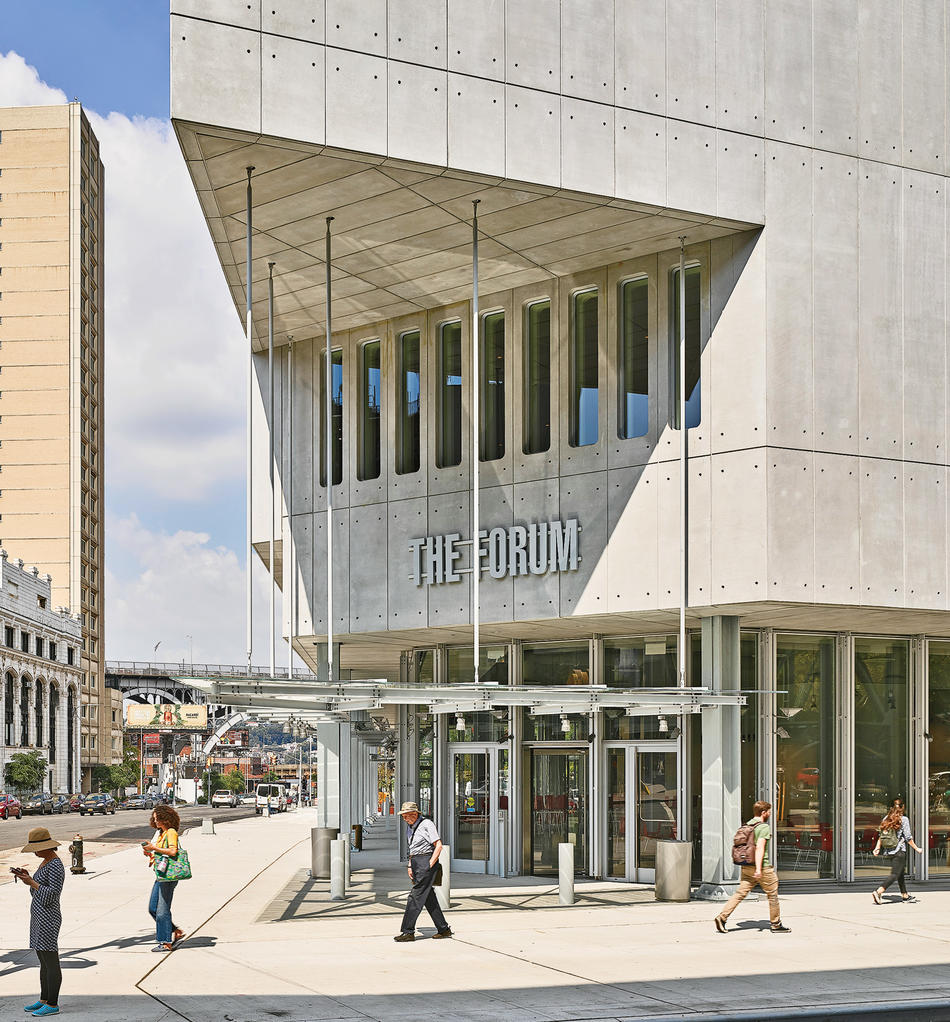“It’s a miracle,” said architect Renzo Piano ’14HON to dignitaries and guests at the opening of the Forum, a three-story structure of glass, steel, and concrete on Columbia’s Manhattanville campus. “It’s not a small miracle. It’s a big miracle.” Speaking in the Forum’s 437-seat auditorium this past September, Piano was referring not only to the conclusion of a process that began when President Lee C. Bollinger arrived at Columbia in 2002 and identified seventeen acres in West Harlem as the ideal site for Columbia’s expansion, but also to the cross-disciplinary, cross-cultural partnerships that the Forum promises to foster. “The building,” he said, “is about society.”
The Forum (the name was inspired by the open-air social and cultural hub of ancient Rome) is triangular in shape, one sharp gray vertex looming prow-like over the corner of Broadway and 125th Street. As the symbolic entranceway to a campus without gates or walls, the Forum joins the Lenfest Center for the Arts and the Jerome L. Greene Science Center to complete the trio of Renzo Piano Building Workshop structures in Manhattanville. “When you put together science, art, and community — it’s huge,” said the architect. “You know, I’m Italian. I get romantic.”
Guests arrived mid-afternoon, entering the Forum’s glass-enclosed public space. They milled amid the white tables and red-orange chairs, snacked on pastries from the Forum’s café, and checked e-mail using the Forum’s free public Wi-Fi. Then they rode the elevators, whose motors and pulleys, like the pipes running along the high ceilings, are exposed, evoking transparency and industry and reinforcing Piano’s notion of Manhattanville as a “factory of ideas.”
In the auditorium, Bollinger, whom Piano called the “driving force” behind Manhattanville, was, like the architect, enjoying the peculiar sensation of standing inside a fully realized idea. The Forum, he said, is his favorite Manhattanville building, “because it stands for something I cherish and believe in. Its name, its identity, and its function within the University — all connote the mind at work, freedom of thought and speech, dialogue and debate, listening and speaking.”
The Forum is home to two new University initiatives, Bollinger said: Columbia World Projects (CWP), which connects academic work with influential outside partners to solve real-world problems, and the Obama Foundation Scholars program, in which a dozen up-and-coming global leaders spend the academic year immersed in projects, including collaborations with CWP.
Confessing to a late-in-life passion for large seagoing vessels, Bollinger said he also loved the Forum “because it feels like a ship.” He quoted from Moby-Dick — specifically, Ishmael’s musings on the metaphysical magnetism of the sea and its effects on the dwellers of Manhattan, where “right and left, the streets take you waterward.” Melville wrote that “meditation and water are wedded forever,” and that water embodies “the ungraspable phantom of life; and this is the key to it all.” With the arrival of the Forum, a short walk from West Harlem Piers Park and the gleam of the Hudson River, “we lean further toward the water,” Bollinger said, “and the key to it all.”
Mary McGee, executive director of the Forum, wearing an orange jacket that complemented the palette of tangerines and marigolds adorning the Piano interiors, touted the Forum’s mission as a civic and intellectual center. She challenged the University to “live up to its promise” of a campus that breaks down academic and social barriers and ensures “access to Columbia’s resources for the community that it inhabits.”
After the speeches, Renzo Piano stepped outside. The sound of drums rumbled in the near distance. Piano, dressed in a blue jacket and cream khakis, gray hair ruffled by the maritime breeze, walked west toward the propulsive, blood-quickening beat and the Lenfest Center for the Arts. There, on the Lenfest plaza, he saw the source of the vibrations: the Marching Cobras, a New York–based drum line and dance troupe. The architect stood at the perimeter and watched as the Cobras aligned in single file and marched, drumming and dancing, along 125th Street, the Forum’s hypotenuse, before streaming into the building.
The guests looked up from their refreshments and conversations as the drummers christened the space with percussive bursts and rolls — the Forum’s answer to a champagne bottle smashed across the bow.
As Bollinger said in his remarks: “This ship is ready for navigation.”



